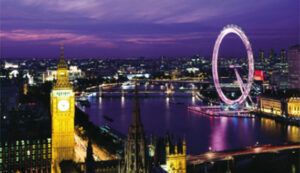London, England
Study Media and Culture at Goldsmith's College, University of London
The Vassar Media and Culture Studies Program in London is open to all majors. Goldsmiths College—ranked top London university in Media and Communications, Music, and Visual Arts—is also among the most respected UK colleges in Anthropology, Cinema Studies, Cultural Studies, Drama, Economics, History, Literary Studies, Political Theory, Psychology, and Sociology.

Vassar students live in Goldsmith’s dormitories on the New Cross campus, South East London, 15 minutes from the central city, and have access to all benefits available to Goldsmiths students. These include research centers, computer labs, clubs, athletic teams, trips around the UK and Europe, counseling, and healthcare. Students are also granted membership to the Students’ Union, library, and fitness facilities at Goldsmiths and all other University of London campuses.
The Vassar Media and Culture Studies Program in London balances immersion in a great global city with the security of a small program and resident Faculty Director, providing community, as well as personal and pedagogical support.
As of fall 2023, the curriculum at Goldsmiths will offer four Vassar credits:
- One seminar taught by the Vassar Faculty Director will introduce students to London's thriving cultural environment through site visits and meetings with notable practitioners. The topic of the seminar varies from year to year.
- Three Goldsmiths modules; at least one of these modules must be a Media and Communications course. Otherwise, students may select a course from among more than two dozen multidisciplinary offerings.
For more information about these possibilities and for the course descriptions, please consult the Goldsmiths catalogue.
This program is offered only during the Fall Semester.
Fall 2025 Seminar Topic:
The Thames as “Liquid History”: London’s Flowing Spine as Medium
Resident Faculty Director: Lisa Paravisini-Gebert, Professor of Hispanic Studies on the Randolph Distinguished Professor Chair
The River Thames runs through the city of London like a flowing spine. This course explores the river—which 19th-century trade union and politician John Elliot Burns called the city’s “liquid history”—as a defining geographical marker whose study allows us to enter into the depths of London’s historical, cultural and environmental richness. In the process, we engage media practices across historical periods, cultural settings, methods and technologies to deepen our understanding of the city’s past, present and threatened future. The course combines lecture and discussion with field explorations and a digital cartography group project.
This multidisciplinary course begins with an overview of the river and its intimate relationship with the city, using Anne Friedberg’s The Virtual Window, Peter Ackroyd’s engaging “biography” of the Thames, and an extensive cruise of the river to begin to understand its geography, history and architecture. It is divided into two distinct segments.
The first segment (weeks two to five) focuses on history, literature and artistic representation, examining the history of the river as the city’s iconic element through the “windows” of literature, early photography, film and art (most especially through Turner’s magnificent books of sketches of the Thames at the Tate Britain). This segment will also serve as an invitation to the students to explore the British institutions set along the river, from Parliament (and its many representations) to the Tate Britain. This first half of the class closes with the reading of Charles Dickens’ 1865 novel Our Mutual Friend and a tour of Dickens’ Thames.
In the second segment of the class (weeks six to eleven) we focus on the 21st century, moving from architecture and urban development along the Thames to an examination of environmental concerns as London faces the impact of climate change. We begin with a class project to develop a digital cartography of the Thames Path (a walkway along the riverbank that extends from Oxford to the Thames Barrier) through soundscapes, photography, video and narrative, mapping, in turn, the South Bank District’s rebirth as an artistic and entertainment center through imaginative architectural redeployment. The project will allow us to address issues central to London’s socio-political landscape in the 21st century, which include race, migration, surveillance, and the activities through which its citizens challenge state control. The focus on redevelopment and architecture will usher a discussion of London’s path-breaking and multi-faceted approaches to addressing climate change. Through readings, lectures and visits to relevant sites, we will explore London as a mega-city facing (so far successfully) the perils of rising sea levels.
Readings include Rebecca Solnit’s Wanderlust: A History of Walking (2001), Brandon Labelle’s Acoustic Territories (2010), Mark Pelling and S. Blackburns’ Megacities and the Coast (2014), Kenneth Powell’s 21st Century London (2011), Janet Foster’s Docklands: Cultures in Conflict, Worlds in Collision (1998), Garrett Stewart’s Closed Circuits: Screening Narrative Surveillance (2015), and David Lyons’ Theorizing Surveillance (2006), Richard Doyle’s Flood (2002),among others.